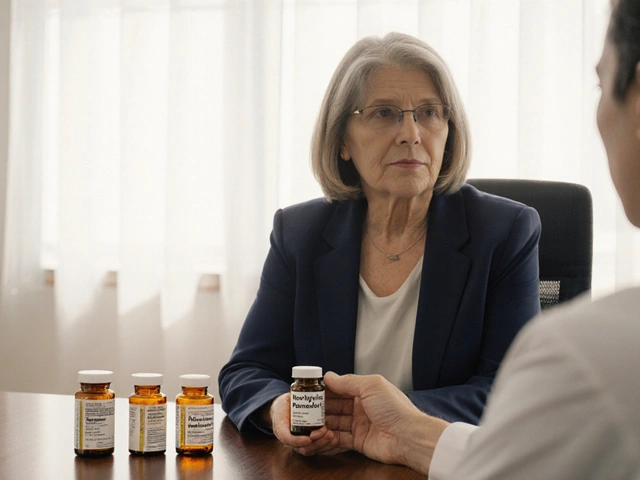When a doctor prescribes a generic medication, many assume it’s a simple step-cheap, effective, and automatically covered. But for providers across the U.S., that assumption often leads to a frustrating, time-consuming battle: prior authorization. Even for generics-medications that have been on the market for years, proven safe, and priced at a fraction of brand-name drugs-insurance companies still demand proof before approving them. Why? And how do providers actually get those approvals without drowning in paperwork?
Why Generics Still Need Prior Authorization
It seems counterintuitive. Generics are cheaper, widely available, and just as effective as their brand-name counterparts. Yet, 89% of commercial health plans still require prior authorization for at least some generic drugs. The reason isn’t about safety-it’s about control. Insurance companies and pharmacy benefit managers (PBMs) use prior authorization to steer patients toward specific generics they’ve negotiated lower prices for. If a patient’s prescription calls for omeprazole 40mg, but the plan’s preferred generic is lansoprazole, the provider must justify why the other one is necessary. This happens even when the patient has already tried and reacted poorly to the preferred option. Common triggers for prior authorization on generics include:- Quantity limits: Requesting a 90-day supply when the plan allows only 30 days
- Duration limits: Prescribing proton pump inhibitors longer than 8 weeks without documentation
- Therapeutic interchange: The insurer wants a different generic manufacturer
- Off-label use: Using a generic for a condition not listed on its FDA label
The Step-by-Step Process: How Providers Actually Get Approval
Securing approval for a generic isn’t a single form. It’s a chain of steps, each with its own rules depending on the insurer. Here’s how it works in practice. Step 1: Identify the payer’s requirementEvery insurer-Medicaid, Medicare Part D, Blue Cross, Cigna-has its own formulary and rules. Some require electronic submission through CoverMyMeds or Surescripts. Others still accept faxes. A few still demand phone calls. Providers need a payer-specific checklist. One mistake-like submitting to the wrong portal-can delay approval by days. Step 2: Gather clinical documentation
You can’t just say, “The patient needs this.” You need proof. The Pennsylvania Department of Human Services says documentation must include chart notes, lab results, or diagnostic tests. For example, if prescribing a specific generic for Barrett’s esophagus, you must attach the endoscopy report showing intestinal metaplasia. If the patient had a severe rash on the preferred generic, document that reaction in detail. Step 3: Submit electronically (when possible)
Electronic prior authorization cuts processing time by 35-50% compared to fax. As of 2024, 78% of commercial insurers and 63% of Medicare Part D plans require electronic submission. Systems like CoverMyMeds auto-populate forms using EHR data, reducing errors. But not all practices have the tech setup. Smaller clinics still rely on medical assistants who manually fill out forms and fax them. Step 4: Wait-and follow up
Approval times vary. Medicaid must respond within 24 hours for urgent cases and 14 days for standard ones. Commercial insurers typically take 5-10 business days. But if documentation is incomplete, the clock resets. A 2024 Judi Health report found that 41% of generic prior authorizations are auto-approved when quantity limits aren’t exceeded and documentation is complete. The rest? They sit in a queue. Step 5: Handle denials
About 18.7% of generic prior authorization requests are denied. The top reasons? Lack of documentation (42%), failure to show medical necessity (38%), and not trying the preferred alternative first (20%). When denied, providers must appeal-with more evidence. This can add another 7-14 days.
Real Stories from the Front Lines
Providers aren’t just following rules-they’re fighting them. Dr. Michael Chen, a gastroenterologist in Ohio, successfully got approval for omeprazole 40mg daily for 12 weeks for a patient with Barrett’s esophagus. He submitted the endoscopy report via CoverMyMeds. Approval came in two business days. But Dr. Lisa Rodriguez in Texas wasn’t so lucky. She prescribed generic sitagliptin after her patient had GI issues with metformin. The insurer denied it, saying she needed to try three failed diabetes medications first-even though the American Diabetes Association guidelines state that metformin intolerance is enough to switch. She had to appeal. The patient waited three weeks. During that time, her blood sugar spiked. These aren’t rare cases. A survey of 1,200 pharmacists found that 83% have seen patients unable to afford the out-of-pocket cost of a generic while waiting for approval. Some skip doses. Others stop taking it entirely.
What’s Working: Strategies That Save Time
Providers who survive the prior authorization maze have one thing in common: they’ve systematized it.- Dedicated staff: MGMA data shows 78% of routine prior authorization requests are handled by trained medical assistants under physician supervision. That frees up doctors to see patients.
- Templates: Capital Rx reports that using standardized templates for common scenarios (like PPIs or diabetes meds) speeds up approvals by 32%.
- Payer checklists: Keep a document for each insurer with their exact requirements: which form to use, who to call, what documents they demand. Update it quarterly.
- Auto-approval pathways: Many PBMs now auto-approve generics if the quantity is within limit and the patient has no history of adverse reactions. Providers who track these rules get faster results.
The Bigger Picture: Why This System Is Broken
Prior authorization for generics saves insurers money-$4.2 billion annually, according to CMS. But it costs providers far more in time and stress. Physicians spend an average of 16.1 hours per week on prior authorizations. That’s nearly two full workdays. Seventy-eight percent say that time could be better spent with patients. Worse, the rules change constantly. One insurer might require documentation for a specific generic manufacturer. Another might only cover one brand of generic, even if others are bioequivalent. Dr. Paul Fischer of GoodRx notes that PBMs are increasingly restricting which generic manufacturers they pay for-forcing providers to justify switching between them, even when the patient is stable. And the regulatory tide is turning. The Improving Seniors’ Timely Access to Care Act of 2023 requires Medicare Advantage plans to respond to standard prior authorization requests within 72 hours-down from 14 days. CMS also mandated standardized electronic transactions for Medicaid managed care as of July 1, 2024, which should cut processing times by 25%. The American Medical Association is pushing state laws to eliminate prior authorization for generics that have been on the market for over five years and have multiple manufacturers. They argue: if a drug has been used safely for years, why require paperwork?
What’s Next: AI, Automation, and Reform
The future of prior authorization isn’t more forms-it’s less human intervention. By 2026, McKinsey predicts that 75% of prior authorization decisions for generics will be made by AI-assisted systems. These tools can cross-reference clinical notes, formulary rules, and patient history in seconds. Express Scripts already reports a 40% increase in auto-approvals for generics since 2023. But there’s a catch. The Congressional Budget Office warns that if these systems aren’t designed with patient needs in mind, they could add $1.2 billion in administrative costs by 2026. The goal isn’t to eliminate prior authorization-it’s to make it smarter. For providers, that means:- Adopting EHR-integrated prior authorization tools
- Training staff to work with automated systems
- Advocating for rules that exempt well-established generics
What Providers Can Do Today
If you’re a provider drowning in prior authorization requests, here’s what to do now:- Identify your top 5 most commonly prescribed generics and check each insurer’s formulary for their prior authorization rules.
- Create a one-page template for each scenario: quantity limits, duration limits, adverse reactions.
- Assign a staff member to handle electronic submissions using CoverMyMeds or Surescripts.
- Build a list of payer contact numbers and response times.
- Start documenting specific reasons for choosing one generic over another-not just “patient preference,” but documented history.
Do generic medications always require prior authorization?
No. Many generic medications don’t require prior authorization, especially those with multiple manufacturers and long safety records. But insurers often require it when there are multiple options, quantity or duration limits apply, or when the generic is being used off-label. About 28% of all prior authorization requests involve generics, mostly due to formulary restrictions, not clinical concerns.
How long does prior authorization for generics usually take?
Approval times vary. Medicaid must respond within 24 hours for urgent cases and 14 days for standard ones. Commercial insurers typically take 5-10 business days. With electronic submission and complete documentation, approvals can come in as little as 1-3 days. If documentation is missing, the process can stretch to 7-14 days or longer after appeals.
Why is prior authorization harder for generics than brand-name drugs?
It’s not harder-it’s different. Brand-name drugs often require prior authorization because they’re expensive. Generics require it because insurers want to steer patients toward the cheapest version, even if it’s not the best fit. So providers must prove why a specific generic is necessary, not just that the drug is needed. This makes the process more about formulary rules than clinical need.
Can patients get their generic medication while waiting for approval?
Sometimes. Some providers give short-term bridge prescriptions or samples to keep patients on therapy. But many patients can’t afford to pay out-of-pocket for the generic while waiting. A 2023 survey found that 83% of pharmacists have seen patients skip doses or stop treatment entirely because they couldn’t afford the cost during the approval wait.
What’s the best way to increase approval rates for generics?
Use electronic submission, document specific medical reasons (like adverse reactions or therapeutic failure), and use standardized templates. Providers who do this see approval times drop by 32%. Also, maintain payer-specific checklists and build relationships with insurer representatives. Auto-approval pathways are increasingly common-know your insurer’s rules for them.






Comments
luke young
November 23, 2025 AT 12:20 PMThis is such a relatable mess. I work in a small clinic and we spend half our day just fighting with insurance portals. It’s not about patient care anymore-it’s about navigating a broken system. I wish there was a button that just said ‘approve this generic, it’s been around since 1998’.
james lucas
November 25, 2025 AT 11:55 AMman i swear i thought generics were supposed to be the easy win but nooo, now we got like 17 different forms for the same drug depending on which insurer the patient has. i once spent 3 hours faxing a form only to find out they needed it submitted through covermymeds and i had the wrong login. my assistant cried. i cried. we all cried. why does this even exist??
ann smith
November 27, 2025 AT 03:11 AMThank you for sharing this detailed breakdown. It’s clear that providers are doing heroic work behind the scenes. The systemic inefficiencies are heartbreaking, but your practical strategies offer real hope. Small changes-like templates and dedicated staff-can make a massive difference. Keep pushing for reform. You’re not alone.
Latonya Elarms-Radford
November 27, 2025 AT 08:26 AMLet’s be honest-this isn’t healthcare. It’s a corporate theater where actuaries play god with patients’ lives. We’ve turned medicine into a spreadsheet game where the only metric that matters is the bottom line. A 40mg omeprazole prescription should not require a dissertation. We’ve lost the soul of healing. We’ve commodified compassion. And now, we’re all just clerks in a machine that grinds people into silence. This isn’t progress. This is moral decay dressed in EHR software.
Mark Williams
November 28, 2025 AT 17:27 PMFrom a systems perspective, the 28% of prior auths on generics represent a classic misalignment of incentives. PBMs are structured to optimize formulary utilization, not clinical outcomes. The lack of interoperability across payer systems creates exponential friction. EHR-integrated automation is the only scalable solution, but adoption is hampered by legacy infrastructure and vendor lock-in. We need HL7 FHIR standardization + AI-driven clinical decision support to reduce cognitive load on clinicians.
Daniel Jean-Baptiste
November 29, 2025 AT 09:22 AMyeah i get it its crazy but honestly in canada we dont really deal with this stuff same med same price pretty much no matter who you are. maybe its not perfect but at least you dont have to fill out 12 forms just to get your blood pressure med. also typo in your link its covermymeds not covermymeds
Ravi Kumar Gupta
November 30, 2025 AT 03:31 AMBro, in India we just walk into a pharmacy and buy the generic for 20 rupees. No forms. No calls. No waiting. Here you have doctors treating patients like bank loan applicants. This is not medicine. This is a scam. I feel bad for your healthcare workers. You’re fighting a war with paper and fax machines in 2024. The system is broken. And it’s not even trying to hide it.
Rahul Kanakarajan
November 30, 2025 AT 12:43 PMWow. So doctors are just lazy and can’t follow basic instructions? Why don’t they just use the damn templates? Or hire an assistant? This whole post sounds like someone who can’t be bothered to learn the rules. If you can’t handle paperwork, maybe you shouldn’t be prescribing meds. This isn’t a crisis-it’s incompetence dressed up as victimhood.
New Yorkers
November 30, 2025 AT 21:51 PMOh please. You think this is bad? Try getting a prescription for insulin in New York. They make you submit a video testimonial from your dog. I’m not kidding. My cousin’s cat had more paperwork than her diabetes meds. This isn’t healthcare. It’s performance art for insurance CEOs. Someone’s getting rich off this chaos. And it’s not you.
David Cunningham
December 1, 2025 AT 15:27 PMBeen there. Had to fight for a generic antihistamine last year. Took 11 days. Patient got worse. We finally got approval… and the pharmacy didn’t have it in stock. So we did it all again. The system isn’t broken. It’s designed this way. And we’re just the hamsters on the wheel.
Jessica Correa
December 2, 2025 AT 03:58 AMthe templates are a game changer honestly i made one for ppi and now its like 5 minutes instead of an hour. also dont forget to call the rep sometimes they can just override it if you sound nice enough lol
manish chaturvedi
December 2, 2025 AT 13:56 PMIn India, we use generics because they are affordable and effective. The concept of prior authorization is foreign to us. It is not about cost-shifting; it is about access. Your system reflects a market-driven approach rather than a health-driven one. Perhaps we can learn from each other.
Nikhil Chaurasia
December 2, 2025 AT 18:09 PMI admire the resilience of providers in the U.S. system. I’ve seen how bureaucracy can drain the humanity out of care. In my country, we don’t have this level of administrative burden. I hope your reforms succeed. You deserve better. And your patients deserve peace.
Holly Schumacher
December 3, 2025 AT 18:40 PMLet’s not romanticize this. The AMA wants to eliminate prior authorization for generics? That’s irresponsible. Not all generics are bioequivalent. Some manufacturers use inferior fillers. If you remove oversight, you open the door to unsafe substitutions. This isn’t about paperwork-it’s about patient safety. Your anecdotal ‘success stories’ are not data. And your ‘templates’ are not clinical guidelines. This post reads like a lobbying pamphlet disguised as journalism.